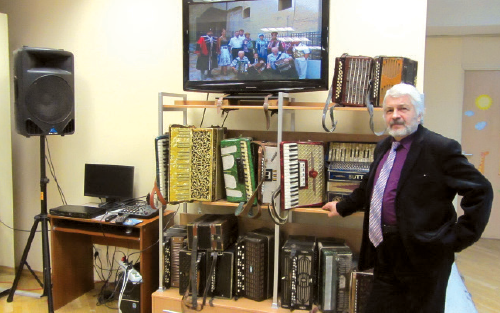Minsker Dmitry Rovensky has been collecting harmonicas, accordions and button accordions for half a century, with over a hundred being hand made

Dmitry Rovensky is a passionate collector of harmonicas, accordions and button accordions
Dmitry’s museum at Minsk’s gymnasium #14 displays several rare accordions, including examples of the ‘talianka’, ‘petrogradka’, ‘saratovskaya’, ‘bandonio’ and ‘vensky stroy’. He shows us an accordion made in 1951 in Tula, brought back by his father after the war; despite being over half a century old, its tone is clear.
Mr. Rovensky can distinguish which master created an accordion just by listening to its tone. In fact, each instrument takes over a year to make. His catalogue includes photos and descriptions of all his exhibits — indicating their place of origin and previous owners. Dmitry even has Belarus’ smallest accordion, which once belonged to a wedding musician, playing couplets. No larger than a loaf of bread, Dmitry praises its tone and vibrancy, despite being over a century old. He proclaims, “It remains true, which is no wonder: it was handmade.”
Industrially produced accordions are often made from low quality wood or, even, fibreboard, while older instruments seem to play independently, needing only a musician to touch them. “Modern accordions are different: you can expand them endlessly, without sound being produced,” Dmitry complains.
One accordion is engraved ‘Zhenya’: the name of the master who created it or the musician who owned it.
Many of Mr. Rovensky’s instruments date from the war years, including a German accordion bought a decade ago which bears a ‘Hitler eagle’ on the label: its head has been defaced, replaced by the words ‘He who lives by the sword, shall die by the sword’. Dmitry explains, “This is an old accordion, presented to me by a woman whose father bought it in 1920. He spent the whole war with it.”
One unique Italian concertina was discovered in an old attic in Pukhovichi. Meanwhile, Dmitry keeps his most expensive accordion at home: he sought it for thirty years before acquiring it and was recently offered 7,000 Euros by another keen collector. Some exhibits arrive broken but Dmitry always mends them. “I found this instrument near a rubbish bin, without buttons, but ‘revived’ it, also repairing its windbags. It plays perfectly now,” he says.
We may hardly realise the value of an accordion but true experts and collectors are ready to pay great sums. Several years ago, an Iranian asked to buy Dmitry’s collection for 100,000 Euros but the collector refused, saying that his instruments are priceless, being part of our history. He also collects drums, tambourines, violins, pipes and cembalos. His hobby has a simple explanation, since his family is full of musicians — including his grandfather and grandchildren. Dmitry has studied music since childhood, learning by ear rather than theoretically, and is keen to preserve folk traditions. By the age of twelve, he played 12 instruments…
Our chat is interrupted by a phone call, with an accordion ringtone. Schoolchildren are about to arrive for a lesson.
MT’s reference:
By late summer 1941, around 12,000 accordions had been sent to the frontline to cheer the spirits of Soviet soldiers. By autumn 1941, another 60,000 had been distributed.











